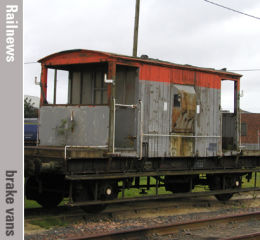Posted 9th March 2021 | 6 Comments
Time’s up for brake vans on freight trains

A LONG-STANDING part of the railway is finally making its farewell bow.
Brake vans, which date back to the earliest days of railways, were needed because for many years the only other brakes on a train were on the locomotive, and drivers could ‘whistle for brakes’ to the guard in the brake van if the train had to stop as quickly as possible.
Continuous brakes, which were applied throughout a train by allowing the pressure to rise in the vacuum pipe, were required by the Board of Trade for passenger trains from 1889, but ‘loose-coupled’ freight trains, in which there were no brakes except manual ones on the individual wagons, remained commonplace until the 1960s.
Newer types of freight working from the 1950s onward included continuous brakes on the wagons, known as ‘fully fitted’ freight, and the last loose-coupled freight trains had run by 1990.
But freight operating instructions had not been brought completely up to date to reflect this change – until now.
References to their required use in some circumstances has continued, including in the so-called ‘White Pages’. Until recently, these contained rules and instructions for staff undertaking safety-critical tasks in freight train operation.
The White Pages have now been withdrawn and the instructions moved into the main Rule Book. The RSSB said the move was also an opportunity to ‘tweak some points and remove requirements which were no longer relevant’ to reflect modern-day operations, which include freight trains as long as 775m.
The RSSB’s director of standards Tom Lee said: ‘Ensuring freight operators have the most up-to-date standards and guidance will enable them to continue to play their critical role in supporting and fuelling the UK economy, and supply goods to businesses and communities nationwide, both efficiently and safely. I’m sure there are many who will remember brake vans both fondly and disdainfully, but their time in the Rule Book has pretty much come to an end, and freight operators can now benefit from enhanced operating instructions that better reflect modern practice.’
Reader Comments:
Views expressed in submitted comments are that of the author, and not necessarily shared by Railnews.

Robert Watt, JOHNSTONE
Re Tony Pearce's comment re Freightliners. Here in Glasgow, on hearing how appalling the ride in the "box" was alleged to be, one of our Senior Officers elected to ride in one. He told us subsequently that, having started from Gushetfaulds FLT, by the time that Rutherglen East Jn, was passed, with 98.35 miles to Carlisle and the earliest opportunity to detrain, he was already howling for it to stop! .
James Negus, Sittingbourne
If any are going for scrap I'll take one!
Andrew Gwilt, Benfleet Essex
There is also one at Shenfield opposite to platform 1 which has been there for a long time and has a nickname called “The Shenfield Shark”.
Tony Pearce, Reading
I think one of the last uses of 'Brake Vans' was a specially converted Box which sat on the end of Freightliner Trains. The ride was so horrific for the Guards that the Unions soon agreed to them going, and I believe the Guard was then positioned in the back of the Loco looking backwards. (I would be grateful if someone would confirm the above and add greater detail.)
king arthur, buckley
When was the last time a brake van was used on a mainline working?
[Not sure what you mean by 'mainline', but the RSSB is a little vague about the dates, saying 'The requirement for a brake van to accompany a “fitted” freight was lifted in 1968, leaving them to clank behind a dwindling number of unbraked trains until the early 80s’ but also ‘Brake vans have not been used widely in revenue-earning services for some 30 years’. This is why our report says ‘by 1990’. It’s as near as we can get, I think!--Ed.]
Sam Green, York
Brake vans haven't been used for years !! Not since the early 80s anyway ! They only lingered on very few trains and jobs for various reasons. The main reasons being safety and practicality ! The main reason for keeping them on certain trains was for the carriage of dangerous goods and where freight trains had to be propelled into depots where it was impractical to change the locomotive from one end of the train to the other! The last reason being the closure of unmanned level crossing gates after the freight train had passed through, where it was inconvenient for the guard to travel in the train's locomotive due to the length of the train!